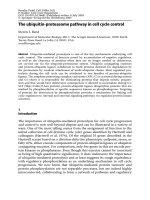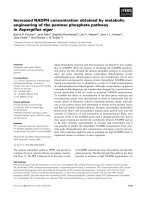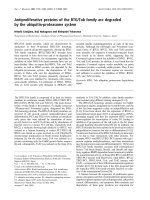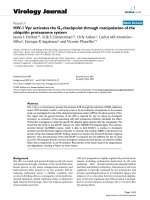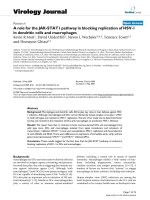Investigation of the role of the ubiquitin proteasome pathway in dengue virus life cycle 2
Bạn đang xem bản rút gọn của tài liệu. Xem và tải ngay bản đầy đủ của tài liệu tại đây (10.39 MB, 41 trang )
!
!
67!
Chapter 3: Results
3.1 Establish a mosquito infection model at Duke-NUS Graduate Medical School
To investigate the role of UPP during DENV infection in mosquitoes, our first aim
was to establish a mosquito infection model in our laboratory. As the colony of Ae.
aegypti was only recently established in 2010 from field-caught specimens in
Singapore, an important preliminary work would be to set up assays to measure
DENV concentration in mosquitoes, as well as their individual organs. To this end,
Ae. aegypti mosquitoes were intra-thoracically inoculated with DENV-2 to ensure all
mosquitoes were infected, and virus kinetics was measured. Two low passage DENV-
2 strains (PR1940 and PR6913) with contrasting virus replication kinetics
(Data from
G. Manokaran) isolated during a 1994 epidemic in Puerto Rico were used. Infected
mosquitoes were harvested at 3, 7, 10, 14 and 17 days post infection (dpi). Infectious
titers were measured using both the mosquito inoculation technique (mosquito
infectious dose 50, MID
50
) and plaque assay (plaque forming unit, PFU), while RNA
copy number was measured using qRT-PCR. Three individual mosquitoes at each
time point were triturated and titrated.
3.1.1 Comparison of mosquito inoculation technique and qRT-PCR to measure DENV
concentration in mosquitoes, vertebrate and mosquito cell cultures, and human sera
Although qRT-PCR has been compared to plaque assay (Bae et al, 2003; Colton et al,
2005; Richardson et al, 2006), the actual ratio of RNA copy number to infectious viral
titer remains unclear. Moreover, it is not known to what degree the infected host, the
virus strain, or time of infection may influence that ratio. In order to better define the
!
!
68!
quantitative and biological relationships between RNA copy number and infectious
DENV, we compared qRT-PCR with the mosquito inoculation technique and plaque
assay using the data we have while optimizing these assays to measure DENV
concentrations in mosquitoes. As a control, quantitative comparisons were performed
using vertebrate and mosquito cell cultures. Both Ae. albopictus derived C6/36 and
African green monkey derived Vero cells were inoculated with 0.1 multiplicity of
infection of each virus. Cell culture supernatants were harvested on 1, 3 and 7 dpi.
The replication kinetics of DENV in live Ae. aegypti mosquitoes, C6/36 and Vero cell
cultures showed that RNA copy number was typically 2–3 logs greater than the
MID
50
titer, regardless of the host tissue or cell culture from which the virus was
harvested (Figures 3-1 and 3-2). When titers per whole mosquito were compared, the
RNA copy number was 100 to 1,000 times higher than the MID
50
titer, which was 100
to 1,000 times higher than the PFU measured by plaque assay (Figure 3-1). This
difference was evident for both DENV-2 strains (PR1940 and PR6913), regardless of
the maximum titers observed in all assay platforms. In general, linear regression
showed that the RNA copy number was correlated with MID
50
titers for DENV-2 in
mosquitoes (P < 0.0001, R2 = 0.567) and cell cultures (P < 0.0001, R2 = 0.950)
(Figure 3-3A). However, the slopes differ significantly (P < 0.001, F = 13.95),
showing that the ratio of RNA copy number to infectious virus may differ when using
different host systems to grow DENV.
Although there is a relatively good general correlation between the MID
50
titers and
RNA copy number using the same host systems to grow DENV, the accuracy of
measuring infectious DENV using RNA copy number may vary based on the virus
!
!
69!
strain or time of infection as the ratio may be significantly different from one another
(Figures 3-3B and C). Different conversion ratios were also shown for different
serotypes of DENV, with 7 day old C6/36 virus supernatants for DENV-1, DENV-3,
and DENV-4 showing 2.0, 0.7, and 2.5 logs higher concentrations by qRT-PCR,
respectively (Table 3-1). Of interest, DENV-3 concentrations varied by only 0.7 log
between the two methods. This small difference could be a unique replication
characteristic of that virus strain or result from the specific time in viral growth when
it was sampled.
!
!
70!
!
!
!
!
!
!
!
!
!
!
!
!
A
B
Figure 3-1 Replication kinetics of DENV-2 (A) PR1940 and (B) PR6913 in adult female Ae.
aegypti mosquitoes. Virus titers are measured by plaque assay (PFU/mosquito !
), mosquito
inoculation technique (MID
50
/mosquito !) and qRT-PCR (RNA copy number/mosquito "
). Error
bar ± SD. N=3.!
!
!
71!
!
!
!
!
!
!
!
!
!
!
!
!
!
!
!
!
!
!
Figure 3-2 Replication kinetics of DENV-2 PR1940 and PR6913 derived in cell cultures
measured by the mosquito inoculation technique (MID
50
/mL !
) and qRT-PCR (RNA copy
number/mL "
). (A) PR1940 in Vero cell culture. (B) PR1940 in C6/36 cell culture. (C) PR6913
in Vero cell culture. (D) PR6913 in C6/36 cell culture. Error bar ± SD. N=3.!
A
B
C
D
!
!
72!
!
!
!
!
!
!
!
!
!
!
!
!
!
!
!
!
!
!
!
!
!
!
!
!
!
!
!
Figure 3-3 Linear regression analysis between RNA copy number and MID
50
. (A)
RNA copy number vs MID
50
in Ae. aegypti mosquitoes ("
) and cell cultures (ο). The
regression equations are DENV-2 copies = 0.653 MID
50
+ 4.93 (R
2
= 0.567) and DENV-2
copies = 1.05 MID
50
+ 2.14 (R
2
= 0.950) respectively. The two slopes are significantly
different. (B) Ratio of genomic equivalents (GE) to MID
50
at different time-points for
PR1940 and PR6913 in mosquitoes. (C) Ratio of genomic equivalents (GE) to MID
50
at
different time-points for PR1940 and PR6913 in cell cultures. Error bar ± SD. N=3.!
A
B
C
!
!
73!
!
!
!
!
!
!
!
!
!
Table 3-1 Comparative titration of C6/36 cell culture virus supernatants by qRT-
PCR and mosquito inoculation (N=3).
DENV serotype
Copy number/mL
MID
50
/mL
Log Difference
(p-value)
DENV-1 EDEN2928
5.81E+10
5.88E+08
2 (0.0019)
DENV-3 Indon1219
1.57E+09
2.88E+08
0.7 (0.0006)
DENV-4 EDEN2270
1.83E+10
5.88E+07
2.5 (0.0009)!
!
!
74!
DENV-2 RNA copy number and MID
50
values were also compared in viremic human
sera, obtained from patients during a 2011 epidemic in Pakistan (Khan et al, 2013). A
greater variation in virus concentration was observed when measuring DENV-2
viremias in 10 human sera (Figure 3-4). The difference in serum viremia level as
measured by the two methods, varied from 2 to 5 logs, depending on the individual
serum. No correlation was observed for RNA copy number and MID
50
titers for
human sera (p=0.3109).
This is the first direct comparison of qRT-PCR with the mosquito inoculation
technique in the measurement of DENV concentration. Our results agree with
previous studies, which show positive correlations between flavivirus RNA copy
number and infectious particles in cell cultures and Ae. aegypti mosquitoes
(Bae et al,
2003; Colton et al, 2005; Richardson et al, 2006). A consistently higher, but variable
RNA copies to infectious virus titer ratio is likely due to the presence of non-
infectious immature virions or defective viral particles. However, the differences in
ratio could also be due to intrinsic variation in virus replication or translational
efficiencies in different host tissues. Of importance was the lack of correlation
between RNA copy number and MID
50
titers in human sera. Viremia in humans is
influenced by the strain of virus, the day of infection the serum was collected from the
patient, and the individual’s previous dengue experience, which influences the innate
and adaptive immune response and thus, the production of noninfectious defective
virus particles. As it is not accurate to quantitate infectious DENV in human tissues
with the commonly used plaque assay, qRT-PCR is often used as a surrogate to
measure viremia in patients. Clearly, our results question the relevance of using qRT-
PCR to quantify infectious virus.
!
!
75!
From Section 3.1, a good general correlation exists between infectious DENV and
genomic equivalents. However, the host, the virus strain, and time of infection may
also influence the ratio of genomic equivalents to infectious DENV. An accurate
measure of infectious virus is critical to understanding dengue virus biology and
pathogenesis, as well as for the development of effective diagnostic tests, vaccines
and therapeutics. Although qRT-PCR is a highly sensitive and useful DENV
diagnostic tool, it measures only viral RNA and cannot replace the mosquito
inoculation assay, which is arguably one of the most sensitive biological assays for
measuring the infectious potential of low passage DENVs. Realizing that this will not
be possible in most dengue diagnostic and research laboratories, qRT-PCR may be
used as a valid and convenient proxy but the data should be interpreted with caution
under specific experimental conditions.
In summary, data from Section 3.1 indicate that a mosquito infection model for
DENV has been established in the insectary in Duke-NUS and this will be used for
subsequent investigations reported in Section 3.2.
!
!
76!
Figure 3-4 Comparative titration of ten viremic (DENV-2) human sera by qRT-PCR and
mosquito inoculation technique.!
!
!
77!
3.2 Investigate the role of the UPP in DENV life cycle
3.2.1 Functional UPP is required for infectious DENV-2 production in mosquito
midguts
Although many studies have identified the UPP to be important for successful DENV
production, how the UPP contributes to DENV life cycle as host factors remains ill
defined. Consequently, none of the licensed proteasome inhibitors have been tested in
vivo due to uncertainty on their mechanism of action. First, we sought to investigate
the role of the proteasome in DENV infection in Ae. aegypti mosquitoes, a natural
insect host for DENV. DENV first establishes infection in the midgut of the female
mosquito after a viremic blood meal. It then spreads systemically to the other organs,
such as the head and salivary glands of the mosquito (Black et al, 2002). Upon the
establishment of a successful infection in these organs, the infection is life-long and
the continued production of DENV, especially in the salivary glands, enables
infection of new susceptible human hosts and thus ensures the survival of DENV. In
the midgut, however, infectious DENV titers decrease after their peak at 7-10 days
post blood meal (dpbm) despite continued replication of its RNA genome (Salazar et
al, 2007).
We first tested if the observation described previously (Salazar et al, 2007) could be
replicated in our hands by characterizing virus replication in the midgut of Ae. aegypti
following ingestion of blood spiked with DENV-2. DENV-2 infection was detected in
midgut epithelial cells as early as 2 dpbm, peaked at 8 dpbm and decreased thereafter.
Paradoxically, measurement of the DENV-2 genomic material by qRT-PCR revealed
!
!
78!
no significant reduction in the viral RNA copy number as late as 21 dpbm (Figure 3-
5A). This observation recapitulated previously reported findings (Salazar et al, 2007).
In contrast, both DENV-2 titers and viral RNA copy number in the heads/thoraces
were positively correlated through to the limit of the lifespan of Ae. aegypti in the
laboratory (Figure 3-5B). This observation recapitulated previously reported findings
(Salazar et al, 2007) and guides our experimental design to study proteasome function
8 days post infection (dpi).
To demonstrate a functional requirement of proteasome on the virus life cycle besides
viral entry, RNAi-mediated gene silencing of the catalytic subunits of the proteasome,
β1 (capase-like activity), β2 (trypsin-like activity) and β5 (chymotrypsin-like
activity), was performed in vivo as described elsewhere (Garver & Dimopoulos,
2007). Female mosquitoes were orally infected with DENV-2 before inoculation of
dsRNA at 3 dpbm to preclude the possibility that knockdown of these genes could
interfere with endocytosis and hence DENV entry in the midgut epithelial cells
(Hicke, 2001; Krishnan et al, 2008). DENV-2 infected mosquitoes inoculated with
dsRNA targeting sequences from pGEM T easy vector served as a control for these
experiments. The mosquito midguts were then harvested and analyzed at 6 dpbm
(Figure 3-6A), the time-point before infectious DENV-2 titers decreased. Efficacy of
RNAi-mediated knockdown was assessed by gene-specific qRT-PCR (Figure 3-6B)
and the effect of their knockdown on viral propagation was measured by both plaque
assay and DENV-specific qRT-PCR. Compared to the dsRNA control, silencing of
the β1, β2 and β5 subunits of the proteasome resulted in a significant reduction of
infectious DENV-2 titers (Figure 3-6C) but not viral genomic RNA (Figure 3-6D).
Correspondingly, ratio of PFU to RNA copy number per midgut decreased
!
!
79!
significantly (Figure 3-6E). Moreover, the proportions of infected mosquitoes were
also significantly reduced with β1, β2 and β5 knockdown respectively (Table 3-2).
Altogether, the data suggests a post-entry role for the UPP in the DENV life cycle.
!
!
80!
A
B
Figure 3-5 Characterization of DENV-2 replication in the midguts and head/thoraces of Ae.
aegypti following ingestion of an infectious blood meal. (A) In the midgut, viral titers increased
linearly until 8 dpbm and declined thereafter. In contrast, viral RNA remained stable between 8 to
21 dpbm. Error bar ± SEM, N=8-10. (B) In the heads/thoraces, the increase in both infectious
particles and viral RNA are coupled over time. Error bar ± SEM, N=8-10.!
!
!
81!
!
0
3 days
6 days
!
dsRNA inoculation
2 µg/mosquito
Plaque assay
qRT-PCR
A
B
C
D
E
Figure 3-6 Proteasome inhibition decouples infectious DENV-2 production from viral RNA
replication in mosquito midguts (A) Workflow of gene silencing assay in Ae. aegypti
mosquitoes. (B) Silencing efficiencies of β subunits of the proteasome were determined by gene-
specific qPCR, and expression values were normalized against control. N=10. (C) Virus titers per
midgut declined significantly after knockdown of β1, β2 and β5 subunits at 6 dpbm.
Student’s t
test, *p < 0.05, **p<0.01.
(D) No statistically significant differences were observed in DENV-2
viral RNA levels per midgut 6 dpbm after gene knockdown. (E) log(PFU/Copy Number) was
significantly lower after β1, β2 and β5 knockdown. N=7-16.
Student’s t test, **p<0.01.
!
!
!
82!
Table 3-2 Percentage of DENV-2-infected mosquitoes after knockdown of
proteasome subunits (p value; Fischer’s Exact Test).
Percentage with infectious
particles detected (%)
Infected/Total
p-value
Virus Control
83.3
10/12
-
dsControl
80.0
16/20
-
dsβ1
31.8
7/22
0.0023
dsβ2
40.0
8/20
0.0225
dsβ5
45.8
10/22
0.0289
!
!
83!
3.2.2 Regulation of UPP-specific genes decouples infectious DENV-2 production
from viral RNA replication in mosquito midguts
The observed decoupling of infectious virus production despite persistent DENV
genome replication after proteasome β-subunit knockdown is reminiscent of the
observed outcome in the Ae. aegypti midgut naturally following an infectious blood
meal. We hypothesized that differential regulation of the proteasome or other genes in
the UPP could be involved in the observed reduction in infectious DENV-2 titers in
the midgut but not the head/thorax. To test this, we utilized RNAseq to analyze the
transcripts of the female Ae. aegypti midgut at 8 dpbm. This approach overcomes the
limitation of mosquito protein-specific reagents as well as difficulty in designing
oligonucleotide primers that accurately complement outbred, field-collected
mosquitoes supplemented monthly (10%) to the Ae. aegypti colony in our insectary.
This methodology also enabled us to characterize genes regulated at the post-
transcriptional level (Sessions et al, 2013) and serves as a reference for future studies.
The experimental workflow is depicted in Figure 3-7A. Mosquitoes that were fed on
blood without spiked DENV-2 served as control. RNAseq analysis was performed for
a pool of 100 dissected midguts and compared to a similarly pooled control using
Cufflinks v13.0 (Trapnell et al, 2010). The quality of our libraries and sequencing
performance was assessed using Partek Genomic Suite v6.6 (Partek Incorporated)
(Table 3-3).
Our results showed no differential regulation in any components of the proteasome.
Instead, several genes within the UPP were differentially regulated (Figure 3-7B).
!
!
84!
Blood meal spiked with
DENV-2
Starve 3-4 days old
female Ae. aegypti
Midgut dissection
Total RNA extraction
Sequencing
Partek, TopHat and Cufflinks
8 days
1 day
!
!
!
!
!
!
!
!
!
!
!
!
!
!
!
!
!
!
!
!
!
!
!
!
Figure 3-7 RNA-sequencing of Ae. aegypti midgut. (A) Experimental workflow of
transcriptomic analysis of Ae. aegypti midgut 8 dpbm. (B) Differentially regulated genes (red for
down-regulation, blue for up-regulation) belonging to the UPP in KEGG pathway (Ae. aegypti).
P-value is lesser than the FDR < 0.1 after Benjamini-Hochberg correction for multiple-testing.
!
A
B
!
!
85!
Table 3-3. Summary of Illumina HighSeq 2000 RNA-sequencing using Partek Genomic Suite v6.6.
Sample ID
Number of
Alignments
Total Number
of Reads
Percentage of reads
which fully overlap exon
Percentage of transcripts
with reads
Total reads
with junctions
Reads with junctions that
are compatible with a
transcript
DENV-2 ST
32567237
15880324
67.3503
81.8814
2202876
1716335
Uninfected
11994298
4676021
55.1425
67.906
346293
245503
!
!
86!
A subset of these were validated by qRT-PCR in a separate experiment using
individual midguts from mosquitoes fed with either DENV-2 infected or uninfected
blood meal (Figure 3-8A). Interestingly, the 3 genes that were down-regulated in the
midgut were significantly up-regulated in the head/thorax at 21 dpbm (Figure 3-8A),
when peak viral titers and RNA levels were observed (Figure 3-5B). These
observations suggest that down-regulation of the 3 UPP-related genes, UBE2A
(AAEL002118), DDB1 (AAEL002407), UBE4B (AAEL006910) in the midgut may be
responsible for the decoupling of infectious DENV-2 production from viral RNA
replication.
If expression of these 3 UPP-related genes were required for DENV production, then
it follows that these genes must be up-regulated prior to the peak of virus replication
at 8 dpbm, to allow for systemic spread of DENV2 to the salivary glands. This must
occur before virus production is suppressed in the midgut. We thus examined the
kinetics of the expression of these 3 genes. Expression levels of these 3 UPP genes
were measured at 2, 4, 6, 8, 11 and 14 dpbm (Figure 3-8B). UBE2A, DDB1 and
UBE4B were significantly up-regulated at 6 dpbm compared to uninfected blood-fed
control, but were all down-regulated from 8 dpbm onwards.
To demonstrate a functional requirement of UBE2A, DDB1 and UBE4B on DENV
production in the mosquito, RNAi-mediated gene silencing was performed. Gene
silencing was also performed for UBE2M (AAEL009026), which was not detected in
our RNAseq analysis as a negative control. Efficacy of RNAi-mediated knockdown
was assessed by gene-specific qRT-PCR (Figure 3-9A). When compared to the
dsRNA control, knockdown of UBE2A and DDB1 produced a similar outcome and
!
!
87!
resulted in a significant reduction of infectious DENV-2 titers (Figure 3-9B) but not
viral genomic RNA (Figure 3-9C). Correspondingly, ratio of PFU to RNA copy
number per midgut decreased significantly (Figure 3-9D). No significant differences
were observed for UBE4B and UBE2M knockdown (Figure 3-9E and F).
To further validate the function of UBE2A and DDB1 in the DENV life cycle, we
tested if silencing of these two genes would also decouple infectious DENV-2
production from RNA replication in the head/thorax of Ae. aegypti. Mosquitoes were
infected via intra-thoracic inoculation to ensure that all mosquitoes have disseminated
infections by bypassing the midgut. At 3 dpi, dsRNA was inoculated into the thorax.
Heads/thoraces of the mosquitoes were harvested 8 dpi. As expected, knockdown of
UBE2A and DDB1 reproduced the decoupling of RNA replication and infectious virus
production; infectious DENV-2 titers decreased (Figure 3-10A) but not DENV-2
RNA (Figure 3-10B). Correspondingly, the ratio of PFU to RNA copy number per
head/thorax decreased significantly (Figure 3-10C). Collectively, these observations
indicate a functional role for the UPP in regulating DENV production in the mosquito
vector.
!
!
88!
A
B
Figure 3-8 Differential regulation of genes belonging to the UPP during DENV infection. (A)
Validation of differentially regulated UPP-specific genes using qRT-PCR. Expression levels of
UPP genes in midguts 8 dpbm and heads/thoraces 21 dpbm were compared. Contrasting
expression levels of UBE2A, DDB1 and UBE4B were observed with these genes being down-
regulated in the midgut, but up-regulated in the head/thorax. Error bar ± SEM, N=12.
Student’s t
test, *p < 0.05.
(B) Gene levels in individual midguts were measured using qRT-PCR, normalized
to GAPDH and compared to uninfected midguts. Error bar ± SEM. N=12-16.
Student’s t test, *p
< 0.05.
!
!
!
89!
A
B
C
D
E
F
Figure 3-9 Functional UPP is required for infectious DENV-2 production in mosquito
midgut. (A) Silencing efficiencies of UPP genes were determined by gene-specific qPCR, and
expression values were normalized against control. Error bar ± SEM. N=10. (B) Virus titers
declined significantly after knockdown of UBE2A and DDB1 at 6 dpbm. N=12-16.
Student’s t
test, *p < 0.05.
(C) No statistically significant differences were observed in DENV-2 viral RNA
levels 6 dpbm after UBE2A and DDB1 knockdown. N=12-16. (D) Ratio of midgut infectious
titers to viral RNA levels after UBE2A and DDB1 knockdown 6 dpbm. N=12-16.
Student’s t test,
*p < 0.05.
(E) No statistically significant differences were observed in virus titers after UBE4B
and UBE2M knockdown. N=7-8. (F) No statistically significant differences were observed in
DENV-2 viral RNA after UBE4B and UBE2M knockdown. N=7-8.!!
!
!
90!
Figure 3-10 Functional UPP is required for infectious DENV-2 production in mosquito
head/thorax. (A) Virus titers at 8 days post intra-thoracic inoculation declined significantly after
knockdown of UBE2A and DDB1. N=8. Student’s t test, **p < 0.01, ***p<0.001. (B) No
statistically significant differences were observed in DENV-2 viral RNA levels after UBE2A and
DDB1 knockdown. N=8. (C) Ratio of head/thorax infectious titers to viral RNA levels after
UBE2A and DDB1 knockdown 8 dpi. N=8. Student’s t test, **p<0.01.!
!
!
!
A
B
C
!
!
91!
3.2.3 Proteasome inhibition with β-lactone did not alter virus entry at non-toxic levels
To elucidate the role of the proteasome on DENV-2 replication, we took advantage of
a subclone of THP-1 human monocytic cells for our investigations (Chan et al, 2014).
The use of human cells is not only clinically relevant for DENV but also overcomes
the limitations in reagent availability for mosquito cells and proteins. Importantly,
inhibition of the proteasome could potentially inhibit virus entry via endocytosis
(Krishnan et al, 2008). This potential confounder can be bypassed by opsonizing
DENV with enhancing levels of antibody where virus entry through proteasome
independent Fc receptor-mediated phagocytosis can occur (Booth et al, 2002). To
demonstrate that proteasome inhibition with clasto lactacystin β-lactone (β-lactone), a
widely used proteasome inhibitor, indeed did not alter virus entry at non-toxic levels
(Figure 3-11A), we measured DiD (1,1'-dioctadecyl-3,3,3',3'-
tetramethylindodicarbocyanine, 4-chlorobenzenesulfonate salt)-labeled DENV in β-
lactone treated cells. Results showed that the proportion of DiD-positive cells were
similar to that of DMSO control. As a positive control, we treated cells with genistein,
a specific tyrosine kinase inhibitor that block Fc receptor-mediated phagocytosis
(Akiyama et al, 1987; Greenberg et al, 1993). Genistein treatment significantly
reduced uptake of humanized 3H5 monoclonal antibody (h3H5)-opsonized DENV in
a concentration-dependent manner (Fig. 3-11-B) (Chan et al, 2011). Similar
observations were made with confocal microscopy where Alexa Fluor 647 labeled
DENV (Zhang et al, 2010) opsonized with h3H5 were internalized in cells pre-treated
with DMSO or β-lactone, while genistein prevented the uptake of virus at 2 hours post
infection (hpi) (Figure 3-11C). Altogether, these data indicate that any antiviral effect
observed during β-lactone treatment is independent of DENV entry.


